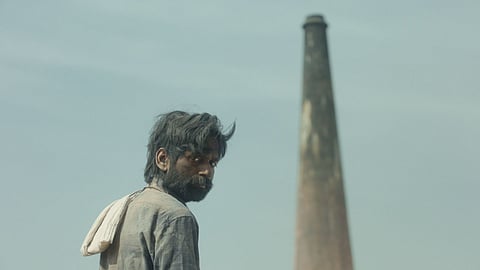

Siddartha Jatla’s sophomore film, In the Belly of a Tiger, which recently premiered at the Berlin Film Festival, has been variously described as a critique of Capitalism. Unable to find a foothold in the city, a destitute family—an elderly couple, their widowed son and his two daughters—returns home to the village. The son has no option but to work in a local brick factory and face exploitation at the hands of the contractor. Meanwhile, a religious play on Lord Vishnu is being performed in the village and a tiger is wreaking havoc on humans. In the Belly of a Tiger flits intriguingly between the real and the surreal.
Born and brought up in Hyderabad, Jatla studied cinematography at the Films and Television Institute of India, Pune, and set base in Mumbai after graduation. He began his career as a filmmaker with the feature film Love and Shukla about a couple’s search for privacy in an overcrowded Mumbai.
We caught up with him in the middle of his filmmaking workshop with the students of Manipal University in Udupi. From there he had plans to travel to China and onwards to Cambodia to hold an international filmmaking workshop in association with Alliance Francaise.
Excerpts:
In the Belly of a Tiger is set in a world that’s very different from the one you explored in Love and Shukla. What made you go rural?
When I started out, I had no money and I needed to make something which was not too expensive. So, the story of Love and Shukla came out of this necessity. I never planned it. In the Belly of a Tiger was inspired by a true incident, a Facebook post about how the young people were sending their elders into the forest to get killed by the tiger to claim compensation. I quickly found out where this was happening and went to that location and that's how the second film started shaping up.
Rural poverty, debt, exploitation… such stories were seen in the films of the 50s. How did you decide to take that narrative forward?
What I have understood from my observation of life is that the powerful will always exploit the powerless. It could be between two individuals or two countries. What you see between Ukraine and Russia, or, you see, a big factory owner trying to exploit the labour. It’s not just about poverty anymore. This is why I wanted to make a strong statement through the film.
But the way of telling the story is very interestingly stylized, the way you use colours, the religious function constantly in the backdrop. Tell me a bit about the narrative strategy.
Indian films have a certain style of showing poverty in monochromatic tones. But when you visit the rural places, stay there, you see striking colours. Even when they are going through crazy times they have these very bright, colourful, well-designed costumes. The houses are aesthetically beautiful and clean. I haven't done much with the location because it is beautiful. I just had to place my camera and shoot it. The farmers are going through problems in the middle of lush greenery.
The religious play on the side features Vishnu, The Saviour. But the irony is that he’s not able to save anyone.
I had a different perception. I wanted to subconsciously tell people to leave God aside. What about how we treat each other? Are we empathic enough? We have the responsibility to treat each other well. God wouldn't be able to help us if we are not kind to each other.
How did you manage to get iconic Japanese composer Shigeru Umebayashi on board for music?
The credit completely goes to my co-writer, Amanda Mooney. She asked me to give three names, the ones I wanted as a composer. AR Rahman came to mind first. Then came Umebayashi because In The Mood For Love soundtrack is one of my favourites. Then there was Hans Zimmer. Umebayashi was the first one to read the script, and immediately said, yes.
There’s something absurdist, matter of fact and moving, all at the same time. Tell me a bit about the tone and tenor of the film.
Right from day one, I knew that the film would be about the elderly couple, and their talk on the night before going to the forest to succumb to the tiger. How emotional it would be! You have lived together for 40 or 50 years together, and this is your last night, and you need to talk, and tell how much you love each other, and then go away. So, I knew the last 20 minutes of the film. The first hour of the film is my observation of one and a half years in the village. Then there’s the love story and the realistic part where I expose the problems, the poverty, the lack of education, the alcohol issues. My next film will be set in China. It’s a love story between two countries. I really believe in love stories.